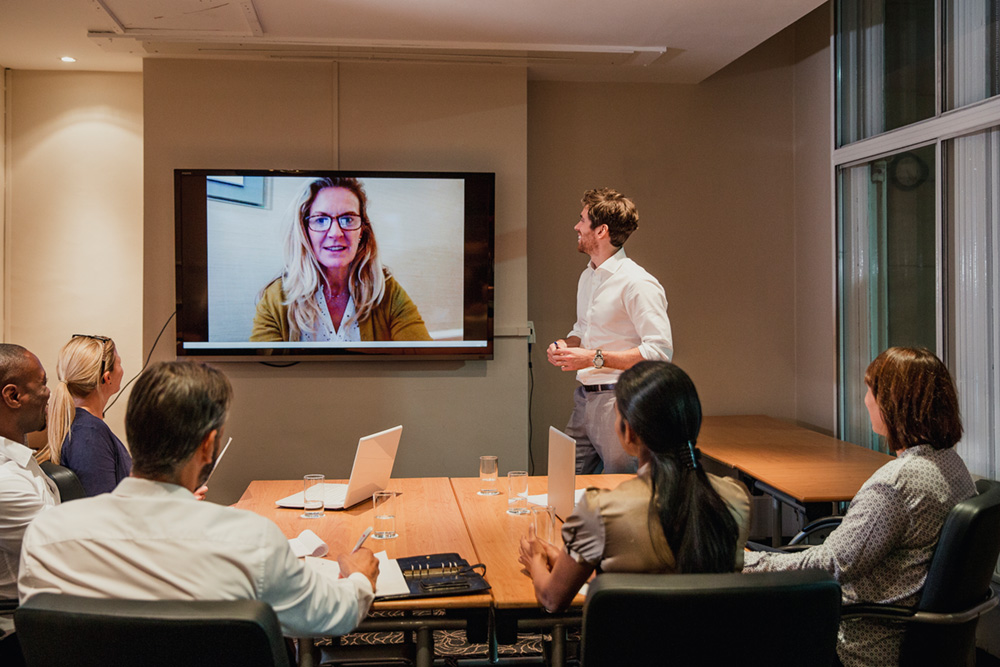Most business professionals, regardless of their industry, participate in team presentations. The team approach ideally reinforces the idea that each person will take ownership of the success of the project or the account and also that each person is an essential contributor. Customers- whether internal or external- often base their decisions on how the team functions as a whole. They know that ultimately things can go wrong so they need to feel that in tough times any member of the team will help them out.
The team, of course, is as effective as its weakest link. The way people communicate on the team is critical to your success. Poor communicators can easily erode the credibility of the entire team. The following baker’s dozen of tips for team presenting will ensure a positive reaction from your listeners.
- Identify the leader of the team. For the sake of everyone involved, a leader should be an appointed. The leader assigns roles and responsibilities, develops a strategy and orchestrates the actual event- including the logistics, topics, order, and visuals. Typically, the senior person is the team lead. This individual should be “hands-on” throughout the entire process and should personally make sure each player is updated with all details and any changes.
- Be Prepared- and that means everyone. Each person on the team should be in agreement on the goal of the meeting and the needs of the audience. They should also have a comprehensive understanding of the how the customer makes buying decisions, how the customer conducts business, who his customers are and what his attitude is towards your company and your product. At a bare minimum, there should be a mandatory pre-meeting conference call or face-to-face meeting where these issues are discussed and questions answered. Team members should also understand the game plan for the engagement, the order of speakers and time allotment.
- Brainstorm as a group or as individuals the questions you will potentially be asked and submit them to the team lead. The leader should e-mail all members the potential questions, as well as the answers, for review and comments. Based on areas of expertise, the leader should decide who will field what questions.
- Take the time to know each person and their overall role. It can sound hokey, but customers notice when the team seems to know and care about each other. A minute or two of conversation early on to get to know each other and understand the focus of the various presentations can make a difference in the end result.
- Create solution-oriented presentations. Each team member should create his or her own presentation, being careful to make it customer focused and solution oriented. Speakers should remember to incorporate analogies, stories, examples and other audience involvement techniques to increase retention since listeners may be hearing multiple speakers. None of the presentations should be a product sell. As subject matter experts, it is easy to go into too much detail and to overload listeners with too much information. Less is more. In fact, three key points are ideal. If the information isn’t clear from the get-go, customers won’t connect the dots.
- Submit all visuals for review. Customers want to feel that you have prepared the visual support that is geared to their issues and their industry. Customers will notice if the slides seem generic and if more than one speaker is using the same visual. They will also be annoyed if there are too many slides and if the slides are boring and/or too technical. The wise team leader reviews all slides to ensure that they are interesting, informative and intuitive.
- Practice, Practice, Practice. Although it is often logistically challenging to rehearse ahead of time, the more the team can rehearse, the better it is. Team members can provide valuable feedback to each other on areas for clarification, the complexity of slides and presentation skills. The more practiced the team, the more polished presentations will be and the more the customer will conclude this is a confident, knowledgeable team.
- Get there early. Things can go wrong. Equipment can fail. Additionally, by being early, the team can allow for a final debrief before show time and ask any final questions.
- Build rapport. Members of the team should spend time introducing themselves to the client with a firm handshake and strong eye contact. Although small talk builds rapport, be aware that it eats up valuable time. Out of respect for the customer, it is always good to begin the meeting as close to schedule as possible. During the actual presentations, speakers can build rapport by linking to anything the customer has said either that day or earlier.
- Begin strong. The moderator should begin strong by quickly introducing himself and the team, verifying the customer’s needs and stating the goal of the meeting. The team lead should also address the potential impact the identified issues on the customer’s business before launching into a solution.
- Link presentations together with effective transitions. Listeners need to feel that there is a connection between the presentations. Thus, transitions are very important. As each speaker wraps up his own presentation, he should introduce the next team member and preview the subsequent topic. Transitions provide the presenter with an opportunity to brag about the new speaker’s credentials and the reason for being included on the team. They also allow the possibility of some humorous anecdotes so that the new speaker can play off of them. When the new speaker begins, he should make references to what has been said earlier so that the customer continues to see continuity between presentations and remembers key points.
- Pay attention. It is easy to be consumed with one’s own presentation and one’s own speaker notes. However, customers will notice if individuals seem oblivious to what is going on. When one speaker is on, the entire team is on. By paying attention, teammates can notice important visual or body language cues that might have been missed by the speaker. These observations can help the next speaker determine whether to adjust content and to assess buy-in.
- Wrap up the meeting with a call to action or next steps. The team lead should summarize what has been covered and how each of these topics solves the customer’s identified issues. He should invite any additional questions, being careful to redirect questions to the appropriate person. A team presentation is not the time for teammates to challenge an answer. If an answer needs correcting, the person should do so tactfully, in a manner that suggests the person is merely adding additional information or insights. Finally, the team lead should conclude with a definite call to action or the appropriate next steps.
Team presentations must leave the customer with the conclusion that the team is capable and has addressed their issues. Presentations should not be solo performances. They must be connected and move the process forward to the desired conclusion. The baker’s dozen of tips will help your team achieve the desired results.
Question: We’re interested in your reaction to this article.
To add your comments click in the “Comment” box below and begin writing. Any questions will be answered by Judy.
Impact Communications, Inc. consults with individuals and businesses to improve their presentation and telephone communication skills. It is not what you know but how you communicate it that makes a difference. When you have to have impact, phone (847) 438-4480 or visit our website, www.ImpactCommunicationsInc.com.

Impact Communications, Inc. was established in 1998. It is a national presentation communication skills and telephone communication skills training company that excels at defining and developing the core elements of effective business communication. With presentation communication skills training, telephone communications skills training, every encounter can be an efficient and lucid transmission of information.






Recent Post Comments